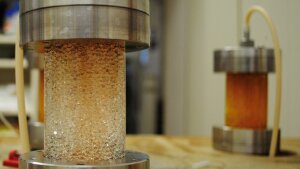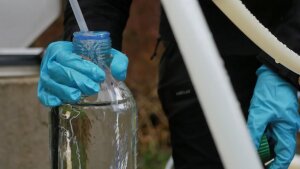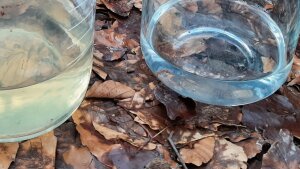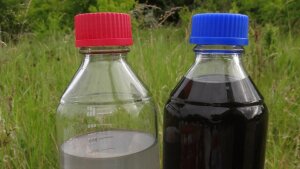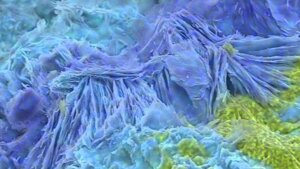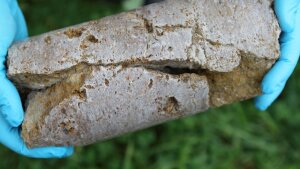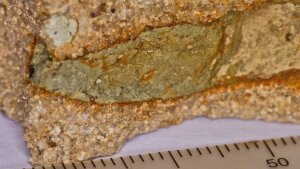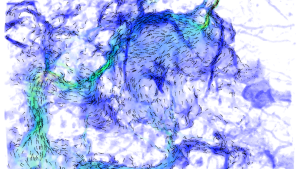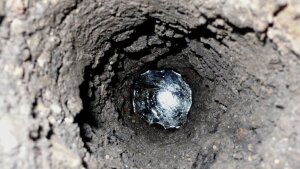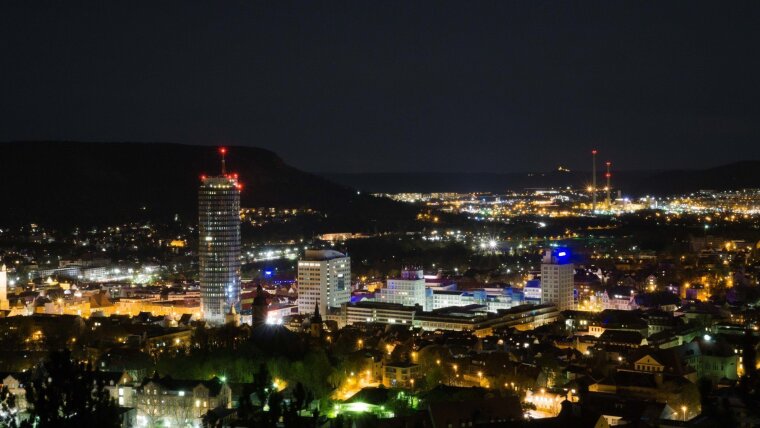
-
Fundamental research foci
Column used for reactive and biological transport experiments
Image: Katharina LehmannThe main motiv for our work is defined by process oriented research in natural and anthropogeneously influenced, biotic, heterogeneous systems on different scales. Objective is a in-depth mechanistic understanding of architecture, dynamics, and functioning of geo- and pedosystems. This requires elucidation of the complex interactions, antagonisms and synergisms of physical, chemical and biological processes, formulation of theories and description of the former in suitable mathematical modells. Progessively, it becomes apparent that the phenomenons on the continuums scale, for example the pedon of an arable or forestry parcel, are controlled and influenced by biochemical and biophysical processes and properties, which occur on the molecular and atomic scale. Therefore, it is one of the central challenges to mechanistically describe and quantitatively determine the extreme large scale transitions, which comprise 9 orders of magnitude in space (nanometres to metres) and up to 21 orders of magnitude in time (femtoseconds to gigaseconds).
To derive a "picture" of composition and structure, i.e. the "architecture" of natural porous media and their temporal variations is a crucial prerequiste. In our hydrogeological research here in Jena, we therefore attempt to create a "window" into the opaque subsurface - soil, unsaturated zone and aquifers. The combination of modern imaging, spectroscopic, microscopic and tomographic techniques with process oriented mathematical modeling and modeling of quantum-mechanical processes represents a promising approach, which allows to reconstruct the structure of natural porous media, reproduce their temporal dynamics and elucidate the interaction of structure and functioning. It repeatedly becomes clear that natural or synthetic, nanoparticulate or colloidal mixed phases play a central role, because they influence properties and functioning of natural porous media. This integrative experimental and theoretical approach is systematically explored in the fundamental research at the Chair of Hydrogeology in Jena in the framework of diverse projects with different project partners.
Current foci of our research are:
- Architecture, dynamics and funcitoning of biogeochemical interfaces: Understanding of process effects and quantification of scale transitions from atom to pedon. This research focus is the subject of a priority program, which is coordinated by the chair of hydrogeology in Jena (www.spp1315.uni-jena.deExternal link).
- Mobility and persistence of dissolved, colloidal- and particulate dispersed particles and contaminants.
- Organo-mineral nanoparticulate and colloidal mixed phases: Formation, characteristics and functioning
- Structural dynamics of natural porous media
- Characterization and mathematical description of the spatial heterogeneity on different scales and quantification of scale transitions
- Formulation of models and numerical modeling of the coupled reactive transport in porous media in the presence of mobile sorbents
- Formulation of models and simulation of the colloid-dependent fluid dynamics in porous systems
- Formation, release, transport, transformation and immobilisation of natural organic matter in soils and aquifers
-
Applied research foci
Groundwater sampling
Image: Robert LehmannFurthermore, the Chair of Hydrogeology in Jena carries out projects in applied subjects considering geo- and pedopotentials of Thuringia and soil technology. Considering the prior, exploration, evaluation and utilization of soils and subsurface with respect to geothermal energy, storage of energy and matter and the natural attenuation potential of natural porous media is foregrounded. The latter aims for a systematical development of soil based techniques for problem solving in the area of preventive and remedial protection of groundwater and soil.
Techniques and methods for protection and remediation are being developed by selective amplification and optimization of natural processes and by the utilization and intellligent combination of soil materials and processes. Classical examples are constructed wetlands, piling, landfill covers, filters for gases and odors. Innovative and advanced concepts, which are being developed here in Jena are "intelligent area filters", which enable the retention and degradation of substances being introduced into soils directly or diffusively by anthropogeneous activities.The subject of remediation techniques, particularly of soil technology, gains progressively more importance. Just thinking about the systematical destruction and contamination of soil resources and groundwater reservoirs in south america, the tiger economies, India and China, it becomes apparent that problems are on the rise, which already have a direct influence on health and life expectation of humans. In China, these problems are already being recognized and counteraction will come into effect in the medium term. This will entail a demand for intelligent and economic protection and remediation techniques.
Applied research areas of the Chair of Hydrogeology at the Friedrich-Schiller-University Jena are:
- Development of innovative remediation techniques
- Development of "intelligent area filters"
- Pedo-/Geopotentials of Thuringia
-
Hydrogeosphere and services provided by the Critical Zone
Soil seepage
Image: Katharina LehmannThe uppermost region of the earth's crust, the "thin skin of the earth", is not only of crucial importance for the life-sustaining production of food and resources. It is also a central tie in the global cycles of information, matter and energy. For example, 25% of the atmospheric carbon originates from processes taking place in soils. Soils contain double the amount of carbon of the atmosphere and triple the amount of carbon contained in the entire vegetation. Yet, not only the global cycles are controlled by the "thin skin of the earth". They have a central function as buffer-, storage-, filter- and transformation medium for water and dissolved and particulate matter. The quality of drinking water, which originates to a large fraction from groundwater reservoirs, rivers and lakes, is decisively influenced by the properties of soils, unsaturated zone and aquifers through which it percolated. The safeguard and restoration of these, for our survival central functions, are inseparately linked to an understanding of biogeochemical and biogeophysical processes and mechanisms, which are the basis of these functions.
